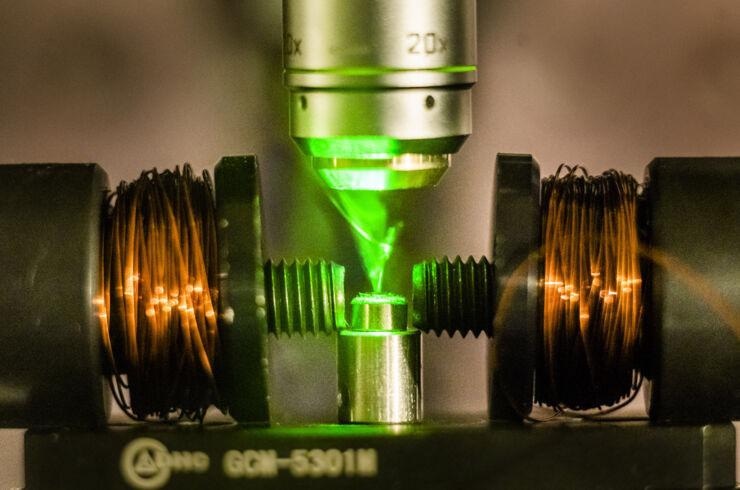Apr 9 2021
The use of information technology in which the spin of electrons is used for information processing in quantum computers might be possible in the future. For a long time, this has been the aim of researchers to use spin-based quantum information technology at ambient temperature.
 Experimental setup similar to the one the researchers have used. Image Credit: Thor Balkhed.
Experimental setup similar to the one the researchers have used. Image Credit: Thor Balkhed.
Now, scientists from Sweden, Finland and Japan have built a semiconductor component where information can be efficiently exchanged between light and electron spin—at ambient temperature and above.
The fact that electrons feature a negative charge is well known, and they also exhibit another property called spin. The latter might be instrumental in the development of information technology. In simple terms, the electron can be visualized to rotate around its own axis, analogous to how the Earth rotates around its own axis.
Spintronics is a potential candidate for future information technology and uses this quantum property of electrons to process, store and transfer information. This offers significant advantages, like lower energy consumption and higher speed compared to conventional electronics.
In the last few decades, advancements in spintronics have relied on the use of metals, and these have been very crucial for the potential to store enormous amounts of data.
However, there would be various benefits from the use of semiconductors-based spintronics, much like the way semiconductors form the backbone of existing electronics and photonics.
One important advantage of spintronics based on semiconductors is the possibility to convert the information that is represented by the spin state and transfer it to light, and vice versa. The technology is known as opto-spintronics. It would make it possible to integrate information processing and storage based on spin with information transfer through light.
Weimin Chen, Project Lead and Professor, Linköping University
Existing electronics operate at ambient temperature and above, and thus a major obstacle in the development of spintronics is that electrons tend to switch and randomize their spin direction with the increase in temperature. This implies that the information the electron spin states code is lost or turns ambiguous.
Hence, it is an essential condition for developing semiconductor-based spintronics in which typically all electrons can be oriented to the same spin state and maintained.
Put simply, they are spin-polarized both at ambient temperature and higher temperatures.
Earlier studies have realized the highest electron spin polarization of about 60% at ambient temperature, which is not sustainable for large-scale practical applications.
Scientists from Linköping University, Tampere University, and Hokkaido University have now realized a more than 90% electron spin polarization at ambient temperature. The spin polarization remained at a high level even up to 110°C.
As explained in Nature Photonics, this technological advance is based on an opto-spintronic nanostructure developed by the researchers using layers of various semiconductor materials. It includes nanoscale regions known as quantum dots.
The size of each quantum dot is about 10,000 times smaller compared to the thickness of a strand of human hair. A spin-polarized electron impinging on a quantum dot emits light—more precisely, it emits a single photon whose state, or angular momentum, is governed by the spin of the electron.
Hence, quantum dots are regarded as promising as an interface for the transfer of information between light and electron spin, as will be required in photonics, spintronics and quantum computing.
As part of the new study, the researchers demonstrate that it is viable to employ an adjacent spin filter to remotely regulate the electron spin of the quantum dots, and at ambient temperature.
The quantum dots are prepared using indium arsenide (InAs), and a layer of gallium nitrogen arsenide (GaNAs) serves as a spin filter. A layer of gallium arsenide (GaAs) is interspersed between both the above layers.
Analogous structures are already in use in optoelectronic technology developed using gallium arsenide, and the team is confident that this can render it simple to combine spintronics with current electronic and photonic components.
We are very happy that our long-term efforts to increase the expertise required to fabricate highly-controlled N-containing semiconductors is defining a new frontier in spintronics. So far, we have had a good level of success when using such materials for optoelectronics devices, most recently in high-efficiency solar-cells and laser diodes.
Mircea Guina, Research Team Head and Professor, Tampere University
“Now we are looking forward to continuing this work and to unite photonics and spintronics, using a common platform for light-based and spin-based quantum technology,” added Professor Guina.
This study was funded by, besides other bodies, the Swedish Research Council, the Swedish Foundation for International Cooperation in Research and Higher Education (STINT), the Swedish Government Strategic Research Area in Materials Science on Functional Materials at Linköping University, the European Research Council ERC, the Academy of Finland, and the Japan Society for the Promotion of Science.
Journal Reference:
Huang, Y., et al. (2021) Room-temperature electron spin polarization exceeding 90% in an opto-spintronic semiconductor nanostructure via remote spin filtering. Nature Photonics. doi.org/10.1038/s41566-021-00786-y.
Source: https://liu.se/en